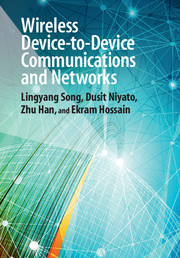Book contents
- Frontmatter
- Dedication
- Contents
- Preface
- Part I Introduction
- Part II Techniques for modeling and analysis of D2D communications
- Part III Resource management, cross-layer design, and security for D2D communications
- 4 Mode selection and resource allocation for D2D communications underlaying cellular networks
- 5 Interference coordination for D2D communications
- 6 Subchannel allocation and time-domain scheduling for D2D communications
- 7 Cross-layer design for device-to-device communication
- 8 Security for D2D communications
- Part IV Applications of D2D communications
- Part V Standardization of D2D communications
- References
- Index
8 - Security for D2D communications
from Part III - Resource management, cross-layer design, and security for D2D communications
Published online by Cambridge University Press: 05 March 2015
- Frontmatter
- Dedication
- Contents
- Preface
- Part I Introduction
- Part II Techniques for modeling and analysis of D2D communications
- Part III Resource management, cross-layer design, and security for D2D communications
- 4 Mode selection and resource allocation for D2D communications underlaying cellular networks
- 5 Interference coordination for D2D communications
- 6 Subchannel allocation and time-domain scheduling for D2D communications
- 7 Cross-layer design for device-to-device communication
- 8 Security for D2D communications
- Part IV Applications of D2D communications
- Part V Standardization of D2D communications
- References
- Index
Summary
D2D communications can be prone to potential security threats. For example, D2D mobiles need to know who else is located nearby so as to pair up. If the location information is spoofed, the interference caused by wrongly paired D2D users can significantly lower the system performance. Additionally, D2D communications between neighboring D2D nodes provide alternative security approaches (physical-layer security) by using channel statistics. In this chapter, we will study the following two security problems in detail.
• Location security: D2D networks need to pair D2D users on the basis of location information so as to use locally available spectrum. This creates a critical loophole for global-positioning-system (GPS)-spoofing attack, where the adversary attacks the GPS signals received by D2D devices, so that D2D devices obtain false available spectrum information with false location information. This security loophole can potentially result in large-scale malfunctioning of mobile D2D networks.
• Data transmission security: Security in D2D communications is traditionally implemented using cryptography, as in other wireless communication systems. Alternatively, physical-layer security provides additional security provided by the channel statistics, which fits well the D2D communications scenarios. We will consider physical-layer security in D2D communications as an underlay to cellular networks with an eavesdropper. Benefiting from the underlaid spectrum reuse, D2D users can contribute to the system's secrecy capacity, while D2D users may interfere with cellular users and decrease their secrecy capacity.
Location security
8.1.1 Problem overview
Dynamic-spectrum-access (DSA) technology has received much attention in industry and academic environments due to its promise of better utilization of spectrum resources compared with the current static spectrum-allocation method. Traditionally, spectrum allocation is static, where FCC assigns communities licenses to use specific frequencies, such as AM, FM, short-wave and citizens' bands, and VHF and UHF television channels, as well as hundreds of less familiar bands that serve cellular and cordless telephones, GPS trackers, air-traffic-control radars, security alarms, radio-controlled toys, and the like. While some of these assigned spectrum bands have been overloaded due to the growth of their users, other spectrum bands are scarcely used.
- Type
- Chapter
- Information
- Wireless Device-to-Device Communications and Networks , pp. 237 - 252Publisher: Cambridge University PressPrint publication year: 2015



